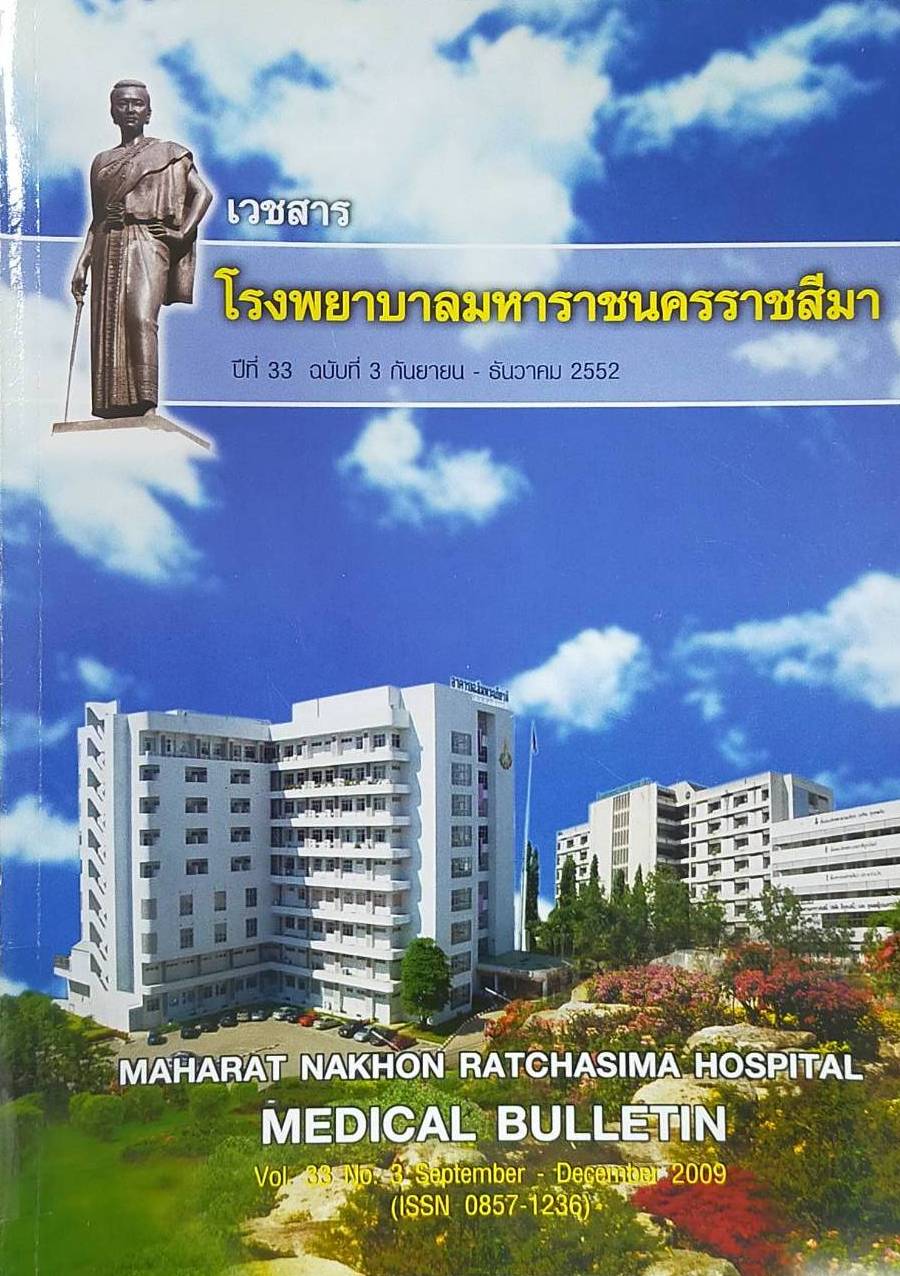การศึกษาโซ่อีลาสโตเมอร์สำหรับดึงฟันเขี้ยวในทางทันตกรรมจัดฟัน
Main Article Content
บทคัดย่อ
วัตถุประสงค์: เพื่อ (1) เปรียบเทียบขนาดของโซ่อีลาสโตเมอร์ 2 ยี่ห้อ ได้แก่ ทัพฟ์®และไดนาเฟก® และเปรียบเทียบขนาดของโซ่อีลาสโตเมอร์ 4 สี (ใส, ชมพู, ฟ้าเจลลี่ และบรอนส์เงิน) ในแต่ละยี่ห้อ (2) ศึกษาขนาดแรงที่ปลดปล่อยจากโซ่อีลาสโตเมอร์ทั้งสอง ตลอดระยะเวลาของการศึกษา 28 วัน และ (3) ศึกษาความยาวของโซ่อีลาสโตเมอร์ซึ่งสามารถปลดปล่อยแรงที่เหมาะสมในการดึงฟันเขี้ยว (350-100 กรัม) วัสดุอุปกรณ์และวิธีการศึกษา: โซ่อีลาสโตเมอร์แบบสั้น, 4 สี (ใส, ชมพู, ฟ้าเจลลี่ และบรอนส์เงิน), ความยาว 5, 6, 7 และ 8 ห่วง จาก 2 ยี่ห้อ ได้แก่ ทัพฟ์® และไดนาเฟก® อย่างละ 10 ตัวอย่าง (320 ตัวอย่าง) ทำการสุมมาวัดขนาดทั้ง เส้นผ่าศูนย์กลางภายใน เส้นผ่าศูนย์กลางภายนอก ระยะระหว่างห่วง ความกว้าง และความหนา ด้วยเครื่องไมโครสโครบ จากนั้นตัวอย่างโซ่อีลาสโตเมอร์ทั้งหมดจะถูกยืดไปที่ระยะ2 8 มิลลิเมตร (ระยะเฉลี่ยระหว่างกึ่งกลางฟันเขี้ยวและปุ่มฟันด้านใกล้กลางและด้านแก้มของฟันกรามซี่ที่หนึ่ง) และทำวัดแรงใน 9 ช่วงเวลา ได้แก่ แรงเริ่มต้น,1 ชั่วโมง, 3 ชั่วโมง, 24 ชั่วโมง, 3 วัน, 7 วัน, 14 วัน, 21วัน และ 28 วัน ด้วยเครื่องอินสตรอน รุ่นแอลเอฟ พลัส ผลการศึกษา: ขนาดของโซ่อีลาสโตเมอร์ 2 ยี่ห้อ ได้แก่ ทัพฟ์®และไดนาเฟก® มีความแตกต่างอย่างมีนัยสำคัญ ในส่วนของเส้นผ่าศูนย์กลางภายใน เส้นผ่าศูนย์กลางภายนอกระยะระหว่างห่วง และ ไม่มีความแตกต่างอย่างมีนัยสำคัญในส่วนของความกว้างและความหนา ในแต่ละยี่ห้อมีความแตกต่างอย่างมีนัยสำคัญในทุกขนาดระหว่าง 4 สี (ใส, ชมพู, ฟ้าเจลลี่ และบรอนส์เงิน) นอกจากนี้ยังพบว่าความยาวของโซอี่ลาสโตเมอร์ที่ให้แรงเริ่มต้นไม่เกิน 350 กรัมและแรงในวันที่ 28 มากกว่า 100 กรัม ได้แก่ 7 ห่างของทั้ง 2 ยี่ห้อและ 8 ห่วงของไดนาเฟก®สรุป: โซ่อีลาสโตเมอร์ในแต่ละยี่ห้อ มีความแตกต่างอย่างมีนัยสำคัญในทุกขนาดระหว่าง 4 สี (ใส, ชมพู, ฟ้าเจลลี่ และบรอนส์เงิน) และ ความยาวของโซ่อีลาสโตเมอร์ซึ่งสามารถปลดปล่อยแรงที่เหมาะสมในการดึงฟันเขี้ยว (350-100 กรัม) ตลอดระยะเวลา 28 วัน ได้แก่ 7 ห่วงของทั้ง 2 ยี่ห้อ และ 8 ห่วงของไดนาเฟก®
Article Details

อนุญาตภายใต้เงื่อนไข Creative Commons Attribution-NonCommercial-NoDerivatives 4.0 International License.
เอกสารอ้างอิง
Von Fraunhofer JA, Coffelt MT, Orbell GM. The effects of artificial saliva and topical fluoride treatments on the degradation of the elastic properties of orthodontic chains. Angle Orthod 1992 Winter; 62: 265-74.
Storie DJ, Regennitter F, von Fraunhofer JA. Characteristics of a fluoride-releasing elastomeric chain. Angle Orthod 1994; 64: 199-209.
Andreasen GF, Bishara S. Comparison of alastik chains with elastics involved with intra-arch molar to molar forces. Angle Orthod 1970; 40: 151-8.
Bishara SE, Andreasen GF. A comparison of time related forces between plastic alastiks and latex elastics. Angle Orthod 1970; 40: 319-28.
Baty DL, Volz JE, von Fraunhofer JA. Force delivery properties of colored elastomeric modules. Am J Orthod Dentofacial Orthop 1994l; 106: 40-6.
Kuster R, Ingervall B, Burgin W. Laboratory and intraoral tests of the degradation of elastic chains. Eur J Orthod 1986; 8: 202-8.
Rock WP, Wilson HJ, Fisher SE. A laboratory investigation of orthodontic elastomeric chains. Br J Orthod 1985; 12: 202-7.
Killiany DM, Duplessis J. Relaxation of elastomeric chains. J Clin Orthod 1985; 19: 592-3.
Brantley WA, Salander S, Myers CL, Winders RV. Effects of prestretching on force degradation characteristics of plastic modules. Angle Orthod 1979; 49: 37-43.
Ash JL, Nikolai RJ. Relaxation of orthodontic elastomeric chains and modules in vitro and in vivo. J Dent Res 1978; 57: 685-90.
Wong AK. Orthodontic elastic materials. Angle Orthod 1976; 46: 196-205.
Kovatch JS, Lautenschlager EP, Apfel DA, Keller JC. Load-extension-time behavior of orthodontic Alastiks. J Dent Res 1976; 55: 783-6.
Hershey HG, Reynolds WG. The plastic module as an orthodontic tooth-moving mechanism. Am J Orthod 1975; 67: 554-62.
Josell SD, Leiss JB, Rekow ED. Force degradation in elastomeric chains. Semin Orthod 1997; 3: 189-97.
Naghdi J. The degradation of force over time in colored open and closed elastic chains. Masters Thesis, University of Maryland at Baltimore, Baltimore, MD. 1994.
Williams J, von Fraunhofer J. Degradation of the elastic properties of orthodontic chains. Master’s Thesis, University of Louisville, Louisville, Kentucky. 1990.
Leiss JB. The degradation of force in orthodontic chain elastics over time. Research Project, Department of Orthodontics, University of Maryland at Baltimore. 1990.
Hixon EH, Atikian H, Callow GE, Mc Donald HW, Tacy RJ. Optimal force, differential force, and anchorage. Am J Orthod 1969; 55: 437-57.
Boester CH, Johnston LE. A clinical investigation of the concepts of differential and optimal force in canine retrac tion. Angle Orthod. 1974;44:113-9.
Storey EE, Smith R. Force in orthodontics and its relation to tooth movement. Aust J Dent 1952; 56: 11-8.
Chung PCK, Wei SHY, Reynolds IR. In vitro testing of elastomeric modules. Br J Orthod 1989; 16: 265-9.
De Genova DC, Mc Innes-Ledoux P, Weinberg R, Shaye R. Force degradation of orthodontic elastomeric chainsa product comparison study. Am J Orthod 1985; 87: 377-84.

